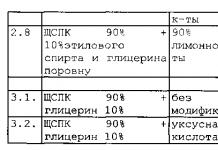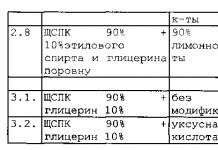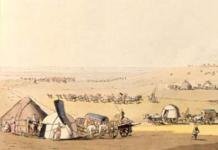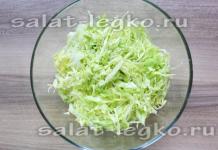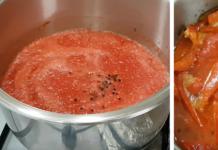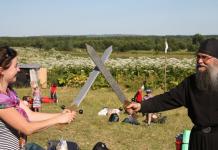Garden blackberries are a close relative of raspberries; the main difference between this crop is the color and taste of the berries. Caring for and growing blackberries in personal plots in the climatic conditions of the Moscow region is more difficult than growing raspberries, since the shoots of these dark-fruited shrubs are more often susceptible to the harmful effects of frost. If you choose blackberry varieties that are optimal for the middle zone, you can get a very good harvest.
In recent years, amateur gardeners have increasingly begun to grow blackberries. The crop is not widespread today, but has recently become increasingly popular; it has a number of advantages and limiting factors (freezing of shoots and lack of planting material).
The blackberry plant is a shrub with a perennial rhizome. Shoots and two-year-old stems are covered with straight or curved thorns up to 1 cm long. When describing blackberry varieties, it is necessary to mention which group the shrubs belong to based on the nature of stem growth: dewberry (with creeping stems) or bramble (with erect stems). Depending on this, the agricultural technology of blackberries is determined - each group has its own growing characteristics.
The shoots have a pentagonal shape in cross section. Blackberry leaves are complex, 3-5-leafed. The flowers are collected in racemes, large, bisexual, self-pollinating. The flowering period is extended; longer flowering is typical for dewberries. Due to the late flowering period, blackberries are not afraid of returning low temperatures. Repair forms are available. The blackberry fruit is a complex drupe.


Pay attention to the photo and description of various varieties of blackberries. The berries of well-known varieties are purple-black, weighing 3-5g (Thornfree, Lawton, Izobilnaya Michurina) or dark red (Texas), with a bluish bloom, shiny, firmly attached to the receptacle. Most varieties bear fruit well in single-varietal plantings.
The ripening of berries is extended - from mid-August to mid-September. The berries are harvested in several stages as the berries ripen.
It is recommended to pick blackberries when the small depression in the center of each drupe is completely filled. The berries can remain on the branches for a long time without losing their commercial qualities. The collected berries cannot be exposed or kept in the sun, even for a short time, as they immediately acquire a bitter taste and a reddish color. Without losing their quality, blackberries can be stored in the refrigerator for 7-10 days at temperatures close to zero. Productivity depends on the variety and its preservation in the autumn-winter period.
In a state of full biological maturity, blackberries are similar in chemical composition to. Blackberries contain a significant amount of P-active substances, less acids, and they have a unique, persistent, subtle aroma. Blackberries contain up to 8% sugar, a lot of tannins, and there are volatile antibiotics that have an antiseptic effect on the upper respiratory tract. Not only berries are used for medicinal purposes, but also decoctions and infusions of leaves and flowers.
Growing blackberries in garden plots
One of the limiting factors for growing blackberries on personal plots and garden plots is warmth and low negative temperatures, characteristic of the southern region. Frost damages mainly the above-ground part - the shoots. Based on this, winter-hardy varieties of brambles should be grown - Lawton and Erie, Kittatinny, Wilson, Cherokee, Darrow, which grow well and bear fruit in the conditions of the southern region. The American Agawam variety, widespread in amateur gardens, bears fruit well, has large juicy berries with a pleasant taste, and produces many root shoots. Ripening later. There are many thorns, but they are soft. And the low-winter-hardy Thornfree (thornless), Izobilnaya Michurina, Texas, and Smutstem are used only as a cover crop; they are classified as dew plants. The shoots of the dewberry initially grow vertically, then bend and spread low above the ground, reaching a length of 2.5 m or more. This explains their freezing in the upper part of the shoot, the wood of which does not have time to ripen due to strong vegetative growth. Cumaniki maintain a vertical position of the stems with an inclined top.
Shrubs are demanding on soil. Agricultural technology for growing blackberries involves cultivating them on humus-rich, loose, breathable soils with a light mechanical composition. It is more drought-resistant compared to raspberries. This stability is due to the ability of vertical roots to penetrate the soil to a depth of 1.5 m.
Watch the video of growing blackberries, which details the planting, care and propagation of these shrubs:
Propagation of blackberries by cuttings and shoots
The most commonly used method of propagating creeping varieties of blackberries is based on the easy ability to take root at the tips of the shoots. To do this, already at the end of July - mid-August, the shoots are tilted, the ends of the tops are buried 10-15 cm vertically into loose, moist soil and pinned. By autumn they take root; they are mulched in winter to protect them from freezing. But separations from the mother plant are made the next year for planting in a permanent place or planted for growing. To increase the yield of planting material, pinning of a young shoot is used, the buds of which begin to germinate rapidly and produce lateral shoots. The process of pinning new side branches continues; they are covered with wet and loose soil. Rooting in this case also occurs by autumn and the following year: from each pinned side shoot a ready-made, high-quality seedling grows.
Another way to propagate blackberries is by root cuttings or green, non-lignified cuttings. A young, intensively growing shoot is cut into cuttings, treated with stimulants such as kornevin, kornerost, etc. based on succinic acid and rooted in a greenhouse under artificial fog conditions.
Garden blackberry planting scheme
The optimal time for planting blackberry seedlings is in the fall at the end of September and in the spring in April, but in the spring you should not delay planting too much, since high temperatures quickly set in in the southern region, there is no precipitation and the seedling may not have time to take root. It is better to plant in a small trench, first add fertilizers for berry crops and humus or compost. The root system of seedlings must be dipped in mash, the stem must be cut at a height of 25 cm from the soil level. It is recommended to plant seedlings in a row. The planting pattern for garden blackberries is 0.8-2 x 2-3 m. After planting, the shoots are cut off above the soil, watered abundantly and hilled up. Blackberries are planted with rooted tops and are given 20% more organic and mineral fertilizers than raspberries.
Blackberries begin to bear fruit from the 3rd year of planting. By the end of the 2nd year of the blackberry growing season, a trellis with three rows of horizontally stretched wire is installed along the row. A wire trellis is fixed at a height every 30 cm. Free-growing (without a trellis) blackberry is inconvenient to care for due to very strong, clinging and painfully wounding thorns. Young shoots are tied vertically as they grow, and then their ends are directed in one or different directions, along a horizontal wire. It is important from the very beginning to orient the shoots in the direction you need. Young growing shoots are pinched when they reach 1 meter in height for additional lateral branching. In the fall, before the onset of frost, the shoots are laid in a row, pinned and covered with agrospan fabric or well-rotted compost or leaves. In spring, the shoots are freed from shelter and tied to a trellis. Next summer, blackberries will bear fruit on side branches. At the same time, powerful young shoots grow from the base of the bush. They should not be left free-growing; immediately tie them in the desired direction, or at least vertically, and then along the top wire. In any case, fruiting shoots must be separated from young ones.
After harvesting, the fruiting stems are cut out, and the young ones are placed in their place, cutting off only the weak tops. Further pruning includes the annual removal of fruit-bearing shoots and their replacement with young ones.
Upright varieties of blackberries with photos and descriptions: Black Satin and Agawam
Here you can see photos and descriptions of blackberries of the Black Satin and Agawam varieties.


Black Satin. The variety is semi-creeping, pinless. Black Satin is a powerful bush with thornless stems. The shoots are hard, powerful, up to 1.5 m high, cannot be bent down, then move to a horizontal position and reach a length of 4-5 m. The berries are black shiny, oblong-round in shape, berry weight 5-8 g, collected in hanging luxurious multi-berry brushes Black Satin berries are harvested in several stages. Tearing is difficult, the taste of the berry is sweet and sour, pleasant, with a slight aroma. The ripening of Black Satin berries begins 10 days earlier than the Thornfree variety. Productivity is high. Requires shelter for the winter.


Agawam. Late summer variety. Annual shoots are green with large thorns; in the second year they change color to brown, bear fruit and die. The description of blackberries of the Agavam variety is similar to the description of the Guy variety. The stems are very tall: up to 3 m or more. Propagated by offspring, flowering in June. Self-fertility is high. The berries ripen at different times, and fruiting lasts for a whole month. The variety bears fruit annually and produces abundant harvests. The berries are black, weighing 3g, large, sweet, have a unique taste, the white receptacle is also edible. Fruits of universal use. The variety is not winter-hardy; the shoots must be insulated for the winter and the base of the bush must be hilled.
Upright blackberry varieties Loughton and Thornfree
Below are photos and descriptions of upright varieties of blackberries, Lawnton and Thornfree.


Lawton– an upright, late-ripening blackberry variety. The bush is powerful, thorny, the berries are large, round, of good quality. Ripening is extended, yield is high.


Thornfree. One of the first commercial blackberry varieties with thornless shoots, created in the USA. A very powerful semi-erect bush. The shoots are hard, unyielding, reaching a length of up to 5 m. Thornless form. When describing Thornfree blackberries, it should be mentioned that these shrubs have decorative leaves and beautiful flowering. The berries are large, oval-shaped, weighing 5-8 g, black, but the ripening of the fruit is not smooth. There are from 30 to 120 berries in a berry cluster. The variety has only one drawback - fully ripe berries have a delicate aroma, but become very soft, the variety is not shelf-stable. The berries begin to ripen in the first ten days of August, fruiting lasts until mid-September. The variety is slightly winter-hardy, requires shelter, but is resistant to shoot anthracnose, rust and stem cancer. The productivity is very high.
Creeping blackberry varieties with photos and descriptions


Abundant. The shoots of this creeping blackberry variety are powerful and thorny. The length of the shoots reaches 2.8-3.5 m. The shoots grow strongly and need to be pinched. The variety begins to bear fruit early and the yield is high. The berry is large, black, elongated, the drupes are large, tightly joined. The berries are of good quality, the average berry weight is 3-4 g. Variety Izobilnaya - late ripening. Low winter hardiness, requires shelter for the winter.


Thornless Logan. The description of blackberries of this variety resembles the description of blackberries of the Izobilnaya variety. The bush is powerful, the shoots are without thorns. The berries are large, shiny, black, round, late ripening. The ripening period is greatly extended. Productivity and winter hardiness are average.


Thornless Evergreen. Almost an evergreen plant, since the foliage does not die during the winter. The berry cluster is branched and drooping. It contains from 25 to 70 medium-sized berries (3-3.5 g). The taste is sweet and sour. When fully ripe, it is sweet, with a subtle pleasant aroma. The berry is suitable for transportation and short-term storage. The drupes are large - this is the only drawback of the variety. The bush is frost-resistant.
Photos and descriptions of blackberries of the Texas and Cheter varieties
Read the description and photo of Texas and Chester blackberries.


Texas. The bush is powerful, vigorous, high-yielding. The shoots are flexible, pubescent, spiny. The Texas variety does not produce root shoots at all. The bush grows only by increasing the number of replacement shoots, which must be normalized, leaving 6-10 pieces each. for each plant. The root system is capable of successfully growing in one place for up to fifteen years without reducing productivity. Late flowering variety. Fruiting and ripening of berries are greatly extended. When ripe, the berries first turn red and then become dark crimson with a waxy coating. The taste is excellent, closer to raspberry than blackberry, and has a pleasant subtle aroma. The berries are large, elongated, up to 5-6 cm in length and 2 cm in diameter, weight - up to 10 g, large drupes. The Texas variety is similar to raspberries even in the shape of the leaves. I.V. Michurin called it blackberry-shaped raspberry. But since the berry is not separated from the fruit, the Texas variety is classified as a blackberry. The fruit is tender, edible, and has a marshmallow-like consistency. The variety is productive, has little winter hardiness, but requires shelter for the winter.


Chester ("Chester Thornless")(USA, Maryland). Obtained by hybridizing the varieties Darrow x Thornfree. One of the most winter-hardy blackberries without thorns. The description of Texas blackberries resembles Loch Tay blackberries. The variety has a medium-late ripening period, the beginning of fruiting is from August 10-15, the harvest is extended. The bush is thornless, of moderate growth vigor, semi-vertical, i.e., suitable for forming and easily covering shoots for the winter. The berry is large, weighing 5-8 g, with a pronounced aroma, black with shine, good for fresh consumption and the market. The berries are transportable and can withstand long-term transportation. In combination with a very high yield, the listed positive qualities have made the variety one of the exclusive commercial varieties in the world in recent years.
New varieties of blackberries for the middle zone


Cherokee. Non-thorny large-fruited variety. The bush is powerful. Garden blackberries of this variety have a high yield - up to 15 kg per bush. The berries are large, up to 10 g, black, sweet, juicy, aromatic. The ripening period is extended. Requires shelter for the winter.


Ebony. A new variety of early ripening blackberries. The bush is powerful, the branches are directed vertically, due to which it has a compact structure. The berry is large, up to 20 mm in diameter, sweet, with a delicate taste and pronounced aroma, high dry matter content Brix 15, with dry separation, easily transported. The variety is new. The estimated yield is about 10-15 kg per bush. In home garden cultivation, with proper care, the yield can be an order of magnitude greater. Requires shelter.


Theodore Reimer- one of the best varieties of blackberries from the erect group. The shoots are spiny, the flowers are 2-3 cm, white, the berries ripen early, during the ripening period of late raspberry varieties. The berries are 4-5 g, black, glossy, collected in clusters on large lateral branches. Requires bush formation. Productivity and winter hardiness are high.


Gazda (“Gazda”)(Poland). A variety selected by J. Danek, included in the register of varieties in 2003. It has a medium-sized berry, distinguished by very good taste and yield. The bush is vigorous, with a small number of weak thorns. Ripening - from the 1st decade of August to the end of September. The berries are suitable for both the fresh market and freezing. The variety is very frost-resistant and is not damaged by diseases.


Orkan ("Ogsap")(Poland). A variety selected by J. Danek, registered in 1998 in Brzezne. The variety is non-thorny, with strong bush growth and does not produce basal shoots. The berries are large and very large, cylindrical, black, shiny, with a floral aroma. The variety requires light shelter for the winter, which limits its industrial use in Europe. Not sick. Ripening date is August.


Polar (“Polar”). A new Polish high-yielding variety with increased frost resistance. Like the varieties Gai and Ruszaj, they are created for coverless cultivation in Polish conditions. All of the above varieties require light shelter in the Russian winter to obtain a stable annual harvest. The variety was registered in 2008. The plants are characterized by strong growth and do not sprout. The shoots are thornless, thick, with powerful and durable laterals. The berry is large, elliptical, black, with a strong shine, and tasty. Purpose: for fresh consumption, suitable for all types of processing. Transportability is good. Ripening period is August-September.


Guy (“Gai”)(Poland) registered in 2008. The variety is in many ways identical to the Polar variety. It also has powerful non-lodging shoots, unsuitable for bending down (the formation of a bush is required). Plant growth is very strong, the variety has high growth energy and does not sprout. The berry is large, barrel-shaped, black and shiny, very tasty. A very good variety for commercial production, high-yielding and transportable.


Rushai (“Ruczai”)(Poland). The newest variety by J. Danek, entered into the register in 2009. The variety is winter-hardy, characterized by strong growth and high yield, and does not produce shoots. The shoots are thornless and thick. The berries are of medium and large fraction, elliptical, black with a strong shine, tasty and sweet, dense, with high transportability. The beginning of ripening is mid-August.


Loch Tay ("Loch Tay"). A variety of English selection, obtained by Dr. D. Jennings at SCRI based on a complex hybrid of blackberries, loganberries and raspberries. The bush is semi-creeping, compact, thornless. The berries are large, black, glossy, collected in large multi-berry clusters. The taste is sweet, very good, with aroma. A special advantage of the variety is that the berries are hard and suitable for transportation. They are not affected by gray mold, even in rainy summers. Ripening - from the end of July.


Natchez ("Natchez"). One of the newest varieties in the United States (University of Arkansas, 2007). The variety is very interesting: early ripening, the first berry from July 5th, with a long harvest period. The fruits are very large, long, weighing from 8 to 10 g, black, shiny, very aromatic, and are perfectly preserved when refrigerated. The variety is being tested in our nursery.


Apache (“Apache”)(USA, Arkansas, 1999). A new thornless variety with erect shoots, strong growth and great industrial potential. The berry is very large, 7-10 g, the stated start of ripening is July 25. The berry is black with shine, barrel-shaped, excellent taste and aroma (up to 12% sugar), suitable for fresh consumption and freezing. In terms of productivity, the variety exceeds all previously released erect thornless varieties in the USA. Frost resistance is high; it grows without shelter in Montreal.


Arapaho ("Arapacho")(USA, Arkansas, 1993). The fruit of the hybridization Ark.631 x Ark.883. The earliest thornless blackberry in terms of ripening. The complex of positive qualities makes this blackberry very valuable for commercial plantings and home gardening. The variety is very highly productive, with high frost resistance of shoots - down to -24°C. The bushes are vertical, of medium vigor, thornless, 1.5 m high, resistant to pests and diseases, and not affected by rust. The berries are very large, wide-conical in shape, weighing 6-7 g, black with a strong shine, excellent sweet taste. The important differences of the variety are small and excellent aroma of fresh berries.


Karaka Black ("Karaka Black"). A new large-fruited variety from New Zealand, which has a complex genealogy (it is a complex hybrid of various types of blackberries and raspberry-blackberry hybrids). The variety has very large (average weight - 10 g) black, glossy berries, good taste and aroma, capable of long-term storage, transportation, and freezing. The period of berry ripening and harvesting is extended to 6-8 weeks. The yield is very high. The variety is being tested.


Tupi ("Tupi"). A new variety of Brazilian selection, bred in the late 90s, requiring shelter and bush formation. Berries of this variety sometimes end up in Russian supermarkets frozen from Guadalajara, but this cannot give an idea of the real consumer qualities of the variety. The berry is very tasty, glossy black, aromatic, large, weighing 9-10 g, medium ripening. The bush is upright, with small thorns.


Cuachita ("Ouachita"). The variety was recently obtained by scientists at the University of Arkansas (USA). The shoots are thornless, of medium maturity. The variety's berries are of excellent taste, sweet, weighing 6-7 g, suitable for both fresh consumption and processing. The variety is resistant to pests and diseases.


Black Boutte. A new Canadian variety that produces the largest fruit. The length of the berry reaches 51 mm, weighs up to 15 g, unusually black, excellent taste. The bushes of the variety are prickly, although the thorns on the shoots are smaller. Fruits from early July to September. Requires garters on a trellis and shelter for the winter.
Blackberry planting and careWe tend to think of blackberries as wild plants that grow extremely quickly and uncontrollably and have thorny stems. Because of this, many gardeners do not want to mess with it. But few people know that there are thornless and hybrid varieties of blackberries, which do not cause many problems when growing, as when caring for other berries.
Blackberry varieties
Before we talk about growing and caring for blackberries in the spring, let’s take a closer look at what kind of berry it is, what types of it there are and the most common varieties.
So, blackberries come in two types:
- Bushy (kumanika) - has spiny stems that grow in a semi-recumbent position. Its berries are blue-violet and shiny, not large and sweet. It ripens at the end of summer. In nature it grows on the edges and in lowland pine forests.
- Ozhina (gray-gray) - has erect shoots with a white coating and small thorns. The fruits are black, small, very reminiscent of raspberries. They taste sour and juicy. And they ripen in mid-August. Ozhina prefers moist soils and grows in meadows and river banks.
Wild blackberries are unpretentious, but cultivated varieties are a little more capricious. But these hybrids are more beautiful and productive.
Bred in America, this blackberry variety has tall, strong shoots that grow in an arch, as well as many small thorns. Its berries are almost black, medium (weighing 3 grams), with a sweet and sour taste and a wonderful raspberry aroma. They ripen in mid-August. The yield of Agawam is excellent (4 kg per bush). It also has strong immunity to stem cancer, as well as anthracnose and rust.
Darrow
Blackberries of the Darrow variety are characterized by good yield and frost resistance. Its large, strong bush has erect shoots. Its fruits, with a glossy skin and an elongated shape, weigh more than three grams. They taste sour.
Loganberry
The yield of this species is very high: about 5 kg of fruits can be picked from one plant, and later ones are even larger (yielding up to 10 kg) and extremely tasty. They ripen from late summer until the onset of frost. This decorative shrub is very beautiful. It has an arched shape and reaches two meters in length. One disadvantage of this blackberry is its intolerance to frost.
Taylor
This remontant species bears fruit and blooms for a long time. Its strong bush is very unusual with its red-ribbed shoots and a huge number of thorns. Taylor berries are tasty and quite large (about 4 grams). Unfortunately, it does not tolerate winter well, so it needs shelter.
Abundant
This variety, bred by I.V. Michurin, is late, characterized by creeping shoots and rather large curved thorns. Its fruits are large (up to 10g), black, oblong and sweet-sour. Productivity - up to 3 kg per bush. Abundant, it does not tolerate cold very well, so it is necessary to cover it for the winter.
Texas
Another type of blackberry, bred by Ivan Michurin. It is distinguished by the power of the bush and flexible, creeping shoots, like a watermelon, as well as dense large (up to 10 g) raspberry fruits, with a sweet taste and delicate juicy pulp. Its maximum yield is 11-12 kg. Texas is not frost-resistant enough, but is well transportable.
Chokeberry
This variety has fairly powerful bushes (up to 2 meters in height), with an average number of light red thorns. Its fruiting period begins in late summer and continues until early autumn. The fruits are medium-sized, round in shape and shiny black in color. They taste juicy, sweet and have a specific aroma. The yield of Chokeberry is about 2 kg. Winter hardiness is average.
Blackberry planting and care
Choosing the right place to plant blackberries is already half the success. Since the good development of different varieties largely depends on whether they grow in a suitable area. Blackberries in this regard, as in many others, are not particularly demanding in care. Basically, it grows everywhere. But there are still some more preferable places in which it will develop faster and its berries will be sweeter:
- sunny areas;
- loamy, drained soils with an average level of acidity;
- places well protected from the wind;
- areas where there is no stagnant water.
Soil preparation
When caring for blackberries, they begin to prepare the soil a couple of weeks before planting. They do it like this:
- compost or manure (6 kg), superphosphate (100-150 g), potassium sulfate (50 g), ash (300 g) are poured into the pit;
- the fertilizers are mixed well with a layer of soil, filling the hole by two-thirds;
- water and leave so that the soil in the hole settles.
If you plant blackberries in unprepared soil, it's okay. The main thing is to provide her with good care later.
Landing in the ground
The process of planting blackberries in the ground is very simple and easy even for novice gardeners. It is better to do this in the spring, since plants planted in autumn may not survive the cold winter. The most convenient way is to plant blackberries with seedlings.
- We make a planting hole half a meter deep and wide.
- We pour mineral and organic fertilizers there: superphosphate (100g), humus (6kg) and potash fertilizers (50g).
- Mix it all with a shovel, add a little soil (two-thirds) removed during digging (so that the root does not come into contact with the fertilizer);
- Carefully straighten the roots and place the seedling in the hole;
- We fill the top with the remaining soil, making sure that the bud does not go deeper than three meters;
- We compact the soil well, eliminating air gaps;
- We cut off the ground part of the seedling by 30-40cm;
- Water the plant (5 liters of water per bush) and mulch with a five-centimeter layer of humus, peat, sawdust or compost.
Top dressing
Blackberries are garden planting and care for which does not require special skills, like any other crop, it needs feeding and fertilizer. But if you fertilized the soil well when planting, then for the first couple of years you have nothing to worry about. Unless you can add a little nitrogen fertilizer (30 g of ammonium nitrate or 15 g of urea per bush).
After these two years, the plant must be fed every spring and autumn.
- In spring, apply 40-60 g of ammonium nitrate per bush. The earth is well loosened and a five-centimeter layer of mulch is scattered;
- In autumn - 30 g of potassium sulfate and 100 g of superphosphate - on top of the mulch. Everything is composted on top or about eight kg of humus is added. The earth is dug up with a pitchfork to a depth of six to ten centimeters.
Do not forget that fertilizing is carried out only after watering.
Garden blackberries: garter and pruning
Growing blackberries involves loosening the soil, killing weeds and constant abundant watering (make sure the soil does not dry out).
Garter
To make it more convenient to care for blackberries, use a garter to tie the stems to a support. Its role can be played by trellises, arches, and other structures. The choice of support depends on your imagination and the type of plant.
Garters on trellises are done like this:
- They bury pillars two meters high along the planting;
- A wire is pulled between them in four rows;
- The bottom row is 80cm from the soil, each next row is 40cm apart;
- Growing shoots are tied in the form of a fan. If they bend poorly, you should not use excessive force;
- In the fall, branches that have borne fruit are pruned and untied. New shoots are tied in their place. Before this, they are also shortened by one third;
- So that the blackberries do not grow too much upward, but send out side shoots. At the end of autumn, the tops of young shoots are plucked off and pinned to the soil using hooks driven into the ground. This will also help prevent freezing;
- They are covered with straw or sawdust on top;
- After winter, young shoots are raised onto trellises, and old shoots are cut out.
Trimming
As well as fertilizing, there is no need to prune blackberries in the first 2 years. This is done only when inflorescences appear. They are pruned so that the plant forms strong branches and root system, and does not waste energy on fruiting.
The following year, the stems of the plant are cut to 1.5-2 meters for ease of care and harvesting of fruits. Frozen stems are also trimmed without touching the living buds.
At the beginning of summer, the bushes are thinned out. At the same time, young shoots are cut out, leaving about ten of the strongest ones. The tops of young growth are shortened by 7-10 cm.
Result:
Blackberries are a very interesting, unusual and very healthy berry with a delicate taste and slightly tart aroma. A decoction of the leaves perfectly quenches thirst and is also used to treat colds. Knowing all the intricacies of caring for blackberries, you can grow them on your own plot and personally see that all of their features and characteristics are not exaggerated at all.
Blackberry- is a shrub with perennial and flexible shoots that live from 1 to 2 years. There are forms of blackberry, both with and without thorns. It was not previously widespread on the Eurasian continent. This is because other berry bushes previously gained great popularity - raspberries, currants, gooseberries. Holoplasty forms produced larger and sweeter fruits. And the spiked forms are ideal for creating fences and barriers.
On a global scale, the leadership in cultivation is shared by Mexico, the USA, Canada.
Many varieties of this crop were identified, tested and propagated there.
At the moment, the varieties available in our country are a “mix” of American varieties and European forms.
Early varieties of blackberries: description of varieties
Early varieties They allow you to enjoy the berries already in the first month of summer. Their fruits are more sour in taste and less aromatic. But they are suitable for processing and making preserves and jellies.
|
|
|
|
|
|
|
Thornfree– a thornless blackberry variety with semi-recumbent shoots up to 4 meters long. The racemose inflorescence can contain up to 30 berries, inky black, blunt-ended, cone-shaped, dense in consistency, weighing up to 7 grams, ripening in early September. In the first summer, the shoots are smooth and bright green. The leaf is complex, three-five-lobed, wrinkled. The harvest is high and stable. Not damaged by diseases. In the north it requires winter shelter. It is desirable to have support. |
|
|
| Karaka Black– a large-fruited variety, with berries up to 11 grams, with long creeping shoots that require a trellis. The growth vigor of young shoots is normal. There are no thorns. The harvest is good and stable. It is almost not affected by diseases. It tolerates frosts well. Responds well to organic fertilizers. |
Mid-season blackberry varieties: description of varieties
Mid-season blackberry varieties continue the berry picking season further, taking up the baton from the early varieties. They have a more compact and friendly maturation. Their fruits produce thicker and richer juice. Among these varieties there are both thorny and thornless.
|
|
|
|
|
|
 Chačanska Bestrna– the berries of this mid-late variety are of impressive size, with a maximum weight of up to 15 grams each. The color is black-violet, “varnish”. The berries are elongated-cylindrical, sweet and very sweet. The aroma is strong, pleasant, the taste is excellent. The harvest is easy. Tolerates transportation well. The overgrowth of fruit branches is good, the inflorescences are concentrated, this makes harvesting much easier. Shoots, fingerlings, tolerate freezing temperatures and disease damage well. Productivity is good and stable. It is advisable to place it on supports. Chačanska Bestrna– the berries of this mid-late variety are of impressive size, with a maximum weight of up to 15 grams each. The color is black-violet, “varnish”. The berries are elongated-cylindrical, sweet and very sweet. The aroma is strong, pleasant, the taste is excellent. The harvest is easy. Tolerates transportation well. The overgrowth of fruit branches is good, the inflorescences are concentrated, this makes harvesting much easier. Shoots, fingerlings, tolerate freezing temperatures and disease damage well. Productivity is good and stable. It is advisable to place it on supports.
|
Late blackberry varieties: description of varieties
Late varieties allow you to enjoy berries until mid-August. The fruits of these varieties can be canned or juiced.
|
|
|
Chester Thornless– a variety that ripens in July and early August, with berries weighing up to 8 grams, black-purple color, refreshing sweet and sour, pleasant taste. The weight of berries from one bush is up to 22 kg. The shoots are “weeping”, there are no thorns. Resistant to frost and disease. |
|
|
|
|
|
Apache– the berry of this variety weighs 10 grams, is black-brown in color, and tastes sweet. This variety has a bush with straight, strong shoots, without thorns. Productivity is average. Disease resistance is high. Withstands transportation easily. Reproduction using root suckers or rooted tops. It tolerates frosts down to -20 normally, covers poorly, and the thickness of the shoots interferes with horizontal laying. Does not tolerate hot climates and air drought. |
Remontant blackberry varieties: description of varieties
Remontant varieties They have a neat and compact, not very tall bush, but under the weight of ripe berries, sometimes the shoots can bend towards the soil, which is why support is really necessary. At the genetic level, this blackberry has the potential to produce two harvests per year. It is allowed to grow them like typical varieties, pressing down the shoots for the winter. Then the initial and very early harvest is obtained from the shoots of the previous year already in June. And the next, most complete harvest is obtained at the end of summer, on the green shoots of this year. It is allowed to grow in an annual cycle, like the same raspberries. Then the shoots that bear fruit over the summer are cut off at the root level in the fall and there is no need for shelter for the winter. Then there is only one harvest, but generous and long-lasting.
|
Ruben– a variety with fruiting on shoots of the current year of growth, high yield. The shoots are powerful, vertical, moderate in height, and do not require a trellis. Thanks to the removal of all shoots for the winter, it tolerates the most severe frosts (-35) and does not require massive chemical treatment against pests and diseases. The berry picking period is one of the later, from the end of August to the end of October for fingerlings. Second-year shoots bear fruit from the end of June to the end of July. The variety is resistant to autumn frosts. |
|
Black Magic– a variety that bears fruit on this year’s shoots. These shoots grow straight up, thorny. But there are no thorns where the berries grow. The shoots themselves can reach a height of up to two meters. But they need support. The berry is large in size, dense, sweet, pleasant taste with a strong aroma. Fruiting begins in mid-August, and second-year shoots bear fruit in July. No break between fruitings. The berries weigh up to 11 grams and are dark purple to black in color. Harvest 6 kg per bush on fingerling shoots. Resistance to diseases and frost is good. |
 Prime Arc 45- a variety with a bush of powerful growth, well leafed, and having thorns only at the bottom of the shoots. When covered, the shoots overwinter normally, otherwise they freeze easily. The berries are black, shiny, large, dense, very sweet, pleasant taste, resistant to transportation and freezing. The harvest is high and stable. Resistance to disease and frost is good. Prime Arc 45- a variety with a bush of powerful growth, well leafed, and having thorns only at the bottom of the shoots. When covered, the shoots overwinter normally, otherwise they freeze easily. The berries are black, shiny, large, dense, very sweet, pleasant taste, resistant to transportation and freezing. The harvest is high and stable. Resistance to disease and frost is good.
|
Blackberries are less popular among Russians than raspberries. But she still has her fans. Blackberries are incredibly healthy; even diabetics can eat them without fear. If we talk about which variety is best to plant, the region where it is intended to be grown, as well as taste preferences, is of great importance. Let's consider the best varieties of blackberries for the Moscow region.
What are brambles and dewberries?
The Moscow Region (and more northern) prefers frost-resistant varieties with juicy, not very large berries, which are represented by erect plants up to three meters high with a drooping crown. This is a bramble. There is a great similarity between bramble and raspberries. This group includes varieties such as Eldorado, Kittatinny, Lawton, Erie, Darrow.
But in more southern regions, where winters are not so cold, creeping varieties, which are united by one name - dewberry, take root better. Dewberry can grow up to six meters in length, and its fruits are much larger than those of brambles.
In the middle Russian regions and specifically in the Moscow region, specially bred blackberries are grown, suitable for the harsh climate of these places. Despite its ability to withstand thirty-degree frosts, the stems should still be bent closer to the ground before winter and preferably covered.
Frost-resistant blackberry varieties for the Moscow region
This is what bramble bushes look like. Even though they are erect, it is still better to tie them to a supportFrost-resistant varieties include:
- Agawam is one of the best varieties for the Middle Zone; it tolerates even forty-degree frosts without shelter, although with the loss of a small part of the fruit buds. The plant is powerful and tall, so it is not possible to bend it down for the winter; it is prickly, but unpretentious. As proof of its unpretentiousness, it continues to grow and even successfully bears fruit in a long-abandoned area. From one bush you can get about four kilograms of black, aromatic, sweet and sour berries, each of which weighs at least five grams. And if you properly care for this variety, feeding it on time and pruning it without sparing, then the yield will be at least five kilograms, and the weight of one berry will reach ten grams.
- Darrow - high winter hardiness, tolerates 35-degree frost without problems. A plant with a powerful, tall trunk and prickly thorns. The yield is good, the weight of one berry is about 4 grams.
- Wilson Early - tolerates winter cold well, is considered one of the earliest, ripening of berries begins in July. Has good disease resistance. The plant is tall with straight shoots drooping to the ground, which is why it is necessary to tie them to a trellis. The black-purple berries are not very large, only about two grams, and are shaped like an egg.
Thornless blackberry varieties for the Moscow region
 This is what dew bushes look like. Their long lashes must be tied to a trellis
This is what dew bushes look like. Their long lashes must be tied to a trellis Blackberries in the wild are impenetrable thorny thickets. When you mention a bush, this is exactly the picture that comes to mind. And it is precisely because of these qualities that many gardeners do not have the desire to plant this plant on their site. But time does not stand still, breeders work conscientiously, and varieties of blackberries completely without thorns have already appeared, to the delight of lovers of this tasty and healthy berry. Such varieties, of course, are becoming wildly popular, since they do not cause much trouble when harvesting and caring for plants. Usually these bushes have a powerful root system. They are calm about the lack of water.
The most famous thornless varieties include:
- Thornfree – the first thornless American variety to appear in Russia. From the genus of large-fruited dewberry, if not pruned, it can reach five meters in length. A plant with large, aromatic, very sweet (without a hint of acid) berries weighing up to six to seven grams and up to four centimeters long. The fruits become soft when fully ripe, so they have a short shelf life. In the Moscow region climate, this variety requires mandatory winter shelter. Usually the shoots are pressed to the ground and covered with soil or mulch, which will be covered by a snowdrift in winter.
- Black Satin – several varieties were crossed (including Thornfree) and the result was thornless Black Satin. When it begins to grow, it looks erect, and later the shoots become drooping and, if not pruned, grow up to 4.5-5 m. The plant with large sweet and sour berries (up to 8 g) does not tolerate frosts well, so it should be cover for the winter.
- Apache is an excellent thornless variety with a medium ripening period (from about July) with black, sweet, large (up to 10 g) berries. Blackberries of this variety are characterized by very high yields, frost resistance and disease resistance.
This group of blackberries also includes varieties such as Loch Tay, Boysenberry, Orkan, Dirksen, Smutsen, Chester.
 Varieties Thornfree and Black Satin are excellent for making hedges
Varieties Thornfree and Black Satin are excellent for making hedges Remontant blackberry varieties for the Moscow region
Low compact bushes of remontant blackberries still need to be tied to a trellis when the harvest begins to ripen. The main feature of this variety is that the plant produces two harvests in one season. One is in June, it is collected from last year’s shoots, the other is in August, the berries ripen on the current shoots, the harvest is much larger than the first. If the shoots are completely pruned before winter, you won’t get two harvests, since there will be no last year’s branches, there will be one, but what a harvest! The best remontant blackberry varieties: Prime Yang, Prime Ark 45, Black Magic, Prime Jim.
The most famous and most productive of the remontant blackberries is the Ruben variety. It belongs to the erect blackberry. Bushes with thick, strong shoots up to two meters high bear fruit with very large berries (up to 14 grams). This variety is famous for its resistance to disease and frost. It does not have any special requirements for the soil; no garter is needed. Last year's shoots produce a harvest already in June, the current shoots bear fruit from late August to late autumn.
Advice#1. If, after fruiting, all the bushes are completely cut down to the ground, they will safely overwinter, covered with snowdrifts, and in the spring the root system will throw out many new young shoots, which will give only one harvest, but a very high one.
★ The best varieties of blackberries by ripening time
There are three groups of varieties according to the ripening period of blackberries:
- Early. The earliest blackberries ripen in early summer, June. The berries of these varieties are quite juicy, but not sweet enough, one might even say they are sour and do not have the proper aroma. But on the other hand, these are one of the first berries of the season. The most popular early and mid-early varieties include Natchez, Helen, Loch Tay, Arpaho, Asterina, Agawam, Columbia Star, Karaka Black.
- Medium and mid-late. They take up the baton from early-ripening blackberries, continuing the harvest period from about mid-July. These varieties produce a more consistent harvest, and the juice from the berries is thicker and richer. The most popular varieties: Triple Crown, Bristol, Auchita, Jumbo, Marion, Loch Ness, Black Satin, Lawton, Chachanska Bestrna.
- Late. Mid-August – the late blackberry harvest is ripening. The berries are used for canning or juice. The most popular varieties: Navajo, Chester Thornless, Texas, Chokeberry.
The most productive varieties of blackberries
Every year new varieties of blackberries appear. But many gardeners - conservative by nature - are not even aware of the successes of breeders, continuing to grow well-known, but, unfortunately, outdated varieties.
Well-known blackberry varieties
These varieties include Thornfree, which appeared more than fifty years ago. Of course, it has a number of advantages: thornless, which means easy to grow, good yield, early ripening, unpretentiousness, winter hardiness, etc. In industrial cultivation of blackberries, this is one of the best varieties.
Old blackberry varieties are valued because of their long-standing acclimatization. But there are also many new varieties, sometimes even superior in quality to the old ones, which are grown in local nurseries. Such varieties are better adapted to the climatic conditions of the growing region, tolerate replanting better, and as a result begin to bear fruit faster. Agave blackberries, which were described above, can also be considered a time-tested variety.
The newest varieties of blackberries
 One of the largest-fruited blackberry varieties is Kara Black. Due to its appearance and good transportability, it is of commercial interest
One of the largest-fruited blackberry varieties is Kara Black. Due to its appearance and good transportability, it is of commercial interest Breeders all over the world are making truly leaps and bounds in developing new varieties. If previously new products appeared mainly in America, now other countries are also pleased with new types of blackberries.
For example, the Karaka Black variety came to the world from New Zealand. This variety can rightfully be called an ordinary miracle and the most promising of the newest varieties. Kara Black is a super early variety, and the berries ripen and ripen on the bushes until late autumn. They are simply huge! The weight of one berry reaches 30 grams! For taste they can be rated “excellent”, sweet and very juicy. Despite their juiciness, they have good transportability and, accordingly, are of commercial interest. It tolerates drought very well and is immune to any diseases. The bush is quite compact, with small (up to 3 m) vines and a few thorns. The only drawback is that it does not tolerate frost well. But if you properly cover the lashes, which bend well and do not break, then there will be no problems with wintering.
But the Natchez variety, a new breeding product bred in Arkansas, has the largest fruits. The semi-erect thornless bush is very convenient to place in a trench for winter shelter. The berries reach 4 cm in length and ripen at the end of June. The taste is excellent, even if they have not reached ripeness, the fruits are still sweet with a pleasant cherry flavor. They tolerate transportation very well, and if you add super-early ripening, then there is obvious commercial interest.
The most popular varieties from this group: Lucretia, Thornfree, Eldorado, Erie, Izobilnaya, Agavam, Smustem, Boysen, Chokeberry, Texas.
How to prepare the soil for blackberries in the Moscow region?
The soil for planting blackberries must be prepared. Lightness of the soil and good drainage are the main indicators, since stagnation of water in the soil is not for blackberries. Kumanika prefers loamy or sandy soil. Dewberry has fewer soil requirements - heavier soils are also suitable, as long as they are fertile. In any case, if the soil lacks the necessary substances, this will, of course, affect the taste of the berries. For example, a lack of potassium will lead to excessive acidity of the fruits and insufficient juiciness.
The soil under blackberries requires fertilizing at least once a year, usually when the blackberries begin to bloom. Proper fertilizers will give plants vitality and increase yield. But you can’t overdo it with fertilizing either - excessive nutrition will have a negative impact on blackberries.
Tip #2. Regular loosening of the soil, removal of weeds, and periodic watering are necessary. In general, everything is as usual.
Blackberry care (key points)
 During autumn pruning you need to leave only 6 or 7 stems
During autumn pruning you need to leave only 6 or 7 stems Blackberries are easy to care for. But she still needs some measures:
- Watering. More frequent watering (twice a week) is only needed for first-year seedlings; from the second year of life, watering should be done only when necessary (during the dry period), as well as when fruits are set.
- Loosening. You need to do this procedure regularly, preferably after watering, while at the same time removing weeds. To make work easier, you can use mulch - it will keep the soil loose and protect you from weeds.
- Feeding. Blackberries may well be satisfied with covering mulch before winter. But if we are talking about increasing productivity, then we need organic fertilizing with compost or humus at the rate of 5 kg per square meter of soil, and during the ripening of the crop, fertilizing with potash fertilizers. Read also the article: →
- Trimming. The main pruning is in autumn, done after picking the berries. You need to cut out all the shoots, leaving about six to eight strong current ones, shortening them by 1/3. In spring, diseased and broken branches are removed. Trimming the tops will awaken the plant and provoke more active development. Read also the article: →
- Shelter. Protects from frost. To cover the blackberry, you need to bend it to the ground and cover it with some kind of covering material or mulch it. Read also the article: →
Answers to frequently asked questions about blackberries
 This is what a blackberry prepared for winter looks like ideally. All that's left to do is cover it up
This is what a blackberry prepared for winter looks like ideally. All that's left to do is cover it up Question No. 1. How to water blackberries?
Despite the fact that blackberries do not like stagnant water in the soil, they need to be watered abundantly when the fruits set and the ripening period begins. Lack of water will lead to the berries becoming smaller and they will not gain the necessary juiciness and sweetness.
Question No. 2. Is it possible to plant blackberries next to a fence, will they get enough sun?
Indeed, for the climate of the Moscow region, the abundance of sunlight is a pressing problem. But the fence, in principle, has nothing to do with it. On the contrary, there are advantages: planting along the fence, firstly, will eliminate the need to make a trellis, and secondly, it will serve as a hedge.
Mistakes gardeners make when growing blackberries in the Moscow region
Blackberries are a heat-loving plant, and it’s not easy for them in the Moscow region’s climate. In general, you don’t need to help her in particular, the main thing is not to interfere, and not to make mistakes in caring for her, namely:
- Watering with ice water. Well or tap water is absolutely not suitable for watering blackberries. In principle, not the water itself, but its temperature. You cannot use water that is too cold, let it be rainwater or heated in a barrel during the day.
- Sunburn of berries due to lack of shelter. If you are not lazy and shade the area with blackberries when the berries are ripening, you can avoid sunburn of the delicate fruits and preserve their presentation and quality. A shading net stretched along the bushes, for example, will help with this.
- Forcibly bending down thick stems for winter shelter. This can lead to broken branches and destruction of the bush. There is no need to bend it down forcibly. But how can you protect them from frost in the climate near Moscow? Throughout the last summer month, you need to hang some heavy object on the tops of the shoots. The branches themselves will bend under its weight. All that remains is to cover it.













